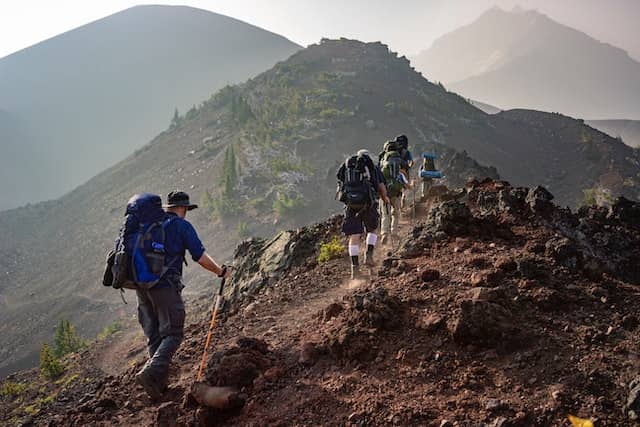Did you know that the United States is home to over 193,500 miles of hiking trails? It’s no wonder that backpacking has become such a popular outdoor activity! As a fellow backpacking enthusiast, I am thrilled to guide you through your first adventure in the great outdoors.
From essential gear and planning tips to tackling challenges and connecting with a supportive community. This comprehensive guide will cover everything you need to know to confidently embark on one of the epic camping types – backpacking. So, lace up your boots and get ready to hit the trail – an incredible adventure awaits!
Understanding the Basics of Backpacking
Backpacking is like taking a magical mystery tour, where you explore the great outdoors while carrying everything you need in a backpack. Think of it as a choose-your-own-adventure where you’ll hike through diverse landscapes, camp under the stars, and truly connect with nature.
What is Backpacking?
Backpacking is an outdoor adventure where you carry everything you need, like clothes, food, and a tent, in a big backpack on your shoulders. Imagine going on a long walk or hike through nature, and instead of returning home at the end of the day, you camp out overnight or for several days. Because you set up camps, many people also refer to backpacking as one of the camping types. However, the story will be different if you decide to stay in a hotel as backpacking not only means going to the forest or unknown terrains but if you have a backpack geared for traveling in urban or rural places, it would still be called backpacking as long as you follow the rules of backpacking.
It’s like being a modern explorer, discovering new places, and enjoying the beauty of nature up close.
- At its core, backpacking is a form of low-cost, independent travel.
- It involves carrying all your essentials (food, clothing, shelter) in a backpack while exploring nature.
- Depending on your goals and preferences, trips can range from a few hours to several months.
Different Types of Backpacking Trips
| Stat/Fact | Data |
|---|---|
| Number of hiking/backpacking participants in the U.S. | 57.8 million |
| Average length of a backpacking trip | 3-4 days |
| Which gender perform most solo travelling | Womens (Over 80% of solo travelers are women |
| Number of hiking trails in the U.S. | Over 193,500 miles |
| Percentage of Americans who participate in outdoor recreation | 53% |
| Average backpack weight for a weekend trip | 15-20 pounds (should not be more than 20% of your body weight) |
| Number of people who visit national parks annually | Over 312 million (n 2022) |
| Number of miles on the Pacific Crest Trail | 2,650 miles |
- Short vs. long trips: From day hikes to extended adventures, there’s a backpacking trip for everyone.
- Solo vs. group travel: Some folks love the solitude of solo trips, while others thrive on the camaraderie of group excursions.
- Themed journeys: Some backpackers focus on specific interests like birdwatching, photography, or peak bagging (climbing mountain summits).
Backpacking Environments
Backpacking environments are the different natural settings where you can enjoy backpacking adventures. They vary greatly, from lush forests to towering mountains, offering unique experiences and challenges for backpackers. Let’s break it down into simpler terms with examples so that an 8th grader can easily understand and visualize what backpacking is and how it’s different from other outdoor or traveling activities.
Mountains
When backpacking in the mountains, you’ll be hiking up and down steep paths, surrounded by impressive peaks and valleys. It’s like going on a thrilling roller coaster ride made by nature, with breathtaking views as a reward. Unlike a simple walk in the park or a family car trip, mountain backpacking requires more effort and preparation to overcome the challenges of higher altitudes and uneven terrain.
Forests
Imagine you’re exploring a vast green kingdom, where trees reach for the sky and the air is filled with the sounds of birds and rustling leaves. Forest backpacking is all about immersing yourself in the natural world, far away from the hustle and bustle of city life. It’s different from a regular vacation or a trip to the beach, as you’ll be navigating through dense vegetation, encountering wildlife, and relying on your skills to find the perfect camping spot.
Deserts
Backpacking in the desert is like stepping onto the surface of another planet. You’ll be surrounded by a sea of sand, unusual rock formations, and hardy plants that thrive in this arid environment. It’s a unique experience that you won’t find in a typical tourist destination, like a crowded amusement park or a guided city tour. Desert backpacking challenges you to adapt to the extreme conditions, conserve water, and appreciate the subtle beauty of this harsh yet captivating landscape.
- Mountains: Reach new heights as you traverse rocky terrain and take in jaw-dropping vistas.
- Forests: Immerse yourself in nature’s lush embrace as you wander beneath towering trees.
- Deserts: Experience the stark beauty of arid landscapes, where every step reveals unique flora and fauna.
The Importance of Planning and Preparation
Just like the Scouts’ motto says: “Be prepared!” Proper planning is essential to ensure you have a safe, enjoyable, and memorable backpacking experience.
Choosing Your Destination
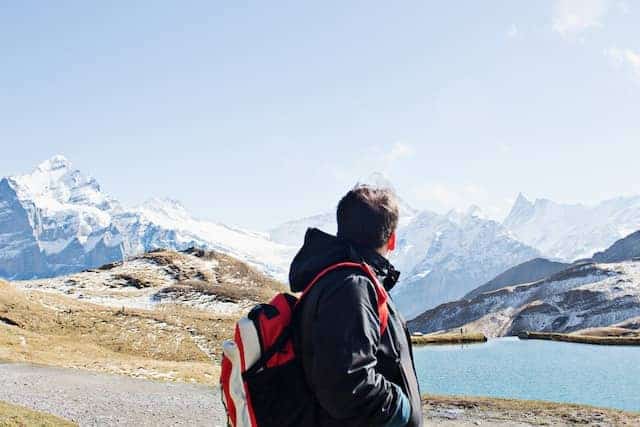
Imagine you’re a modern-day Lewis and Clark, setting out to explore the wild unknown. Choosing your destination is an exciting part of the backpacking journey but requires research and thought.
Factors to Consider
When planning your backpacking trip, there are several aspects to consider that will affect your experience. Let’s break down these factors in a way that’s easy to understand and helps paint a clear picture of what backpacking is and how it differs from other outdoor or traveling activities:
- Weather: The weather can make or break your trip. Imagine stepping out on a bright, sunny day in the Grand Canyon, enjoying the breathtaking views, compared to being caught in a downpour during a hike. It’s essential to research the average temperatures and rainfall for your chosen destination and pack suitable clothing and gear.
- Terrain: The terrain of a trail will determine how challenging or manageable your hike will be. For example, walking on a well-maintained, flat trail in a city park is very different from scrambling up a steep, rocky path in the mountains. Consider factors such as elevation changes (how much you’ll go uphill or downhill), the trail’s roughness, and the overall distance you’ll cover.
- Permits and regulations: Some backpacking destinations require you to obtain permits to access specific trails or camping areas, unlike a simple picnic at a local park. There may also be rules about where you can camp, build fires, or dispose of waste. Make sure to follow these guidelines to protect the environment and ensure a safe and enjoyable experience for everyone.
Best Beginner Backpacking Destinations in the United States
As vast and varied as the Land of the Free itself, here are some top picks for beginner backpackers in the US:
- Yosemite National Park, California: A paradise for nature lovers, Yosemite offers a variety of trails for all skill levels.
- Great Smoky Mountains National Park, Tennessee/North Carolina: With its diverse flora and fauna, this park is a backpacker’s dream come true.
- Arches National Park, Utah: Explore the surreal landscape of red rocks and natural arches in this otherworldly park.
Essential Backpacking Gear
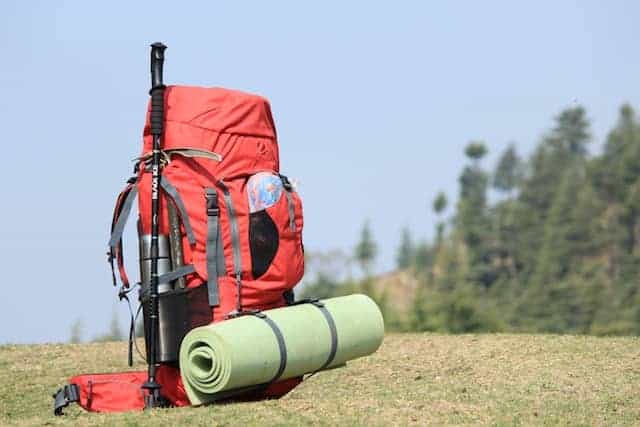
Now that you’re excited about your backpacking adventure, it’s time to talk about the crucial equipment you’ll need. Just like Batman has his utility belt, you’ll want your backpack loaded with the right tools to make your trip a success.
The Big Three: Shelter, Sleep System, and Backpack
These are the foundational items that every backpacker needs, regardless of the trip’s length or difficulty.
- Shelter: A tent or hammock is your home away from home in the great outdoors. It’ll protect you from the elements and ensure you have a cozy place to rest.
- Tip: Look for lightweight, easy-to-set-up options that fit your budget and needs.
- Sleep System: A good night’s sleep is essential, so invest in a quality sleeping bag and pad.
- Tip: Choose a sleeping bag with the appropriate temperature rating for the conditions you’ll encounter.
- Backpack: Your trusty backpack is like your personal sherpa, carrying all your essentials.
- Tip: Look for a backpack with a comfortable fit, good weight distribution, and enough capacity for your gear.
Clothing and Footwear
Dress for success in the wilderness with the right apparel and shoes.
- Layering: Think of your clothing as a personal thermostat, allowing you to adjust for changing weather conditions. Use a three-layer system: base layer (moisture-wicking), insulation layer (warmth), and outer layer (weather protection).
- Footwear: Treat your feet like royalty with comfortable, supportive hiking boots or trail shoes. Don’t forget moisture-wicking socks to keep your feet dry and blister-free.
Cooking and Hydration
Stay fueled and hydrated to keep your energy levels high during your adventure.
- Stove and cookware: A compact backpacking stove and lightweight cookware will help you whip up tasty trail meals. Don’t forget utensils, a lighter, and biodegradable soap for cleanup.
- Water: Carry enough water for your journey and use a filter or purification system to replenish your supply from natural sources.
Navigation and Safety
Prepare for the unexpected and stay on track with these essential items.
- Map and compass: Even in the age of GPS, a good old-fashioned map and compass are vital for navigation.
- First-aid kit: Be ready for minor injuries with a well-stocked first-aid kit. Customize it based on your needs and the trip’s duration.
- Emergency essentials: Pack a whistle, headlamp, and a fire-starting tool for added safety.
Planning and Preparation Tips for Success
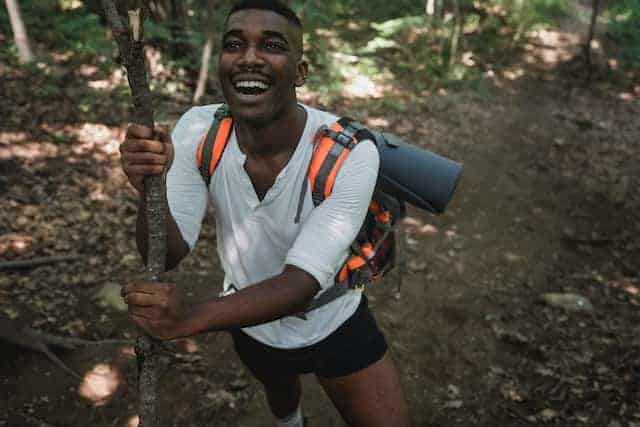
Proper planning and preparation are the keys to a smooth and memorable backpacking adventure. Here are some essential tips to help you get ready for your journey:
Test Your Gear Before You Go
It’s important to familiarize yourself with your gear before hitting the trail. Set up your tent in your backyard, test your stove, and adjust your backpack for a comfortable fit. By ensuring that everything works and you know how to use it, you can avoid unnecessary stress and frustration during your trip. Spending some time with your gear before you set off also allows you to make any last-minute adjustments or replacements, ensuring that you’re fully prepared for the adventure ahead.
Create a Detailed Itinerary
Planning your route in advance will help you stay on track and make the most of your backpacking experience. Research trails and terrain, taking note of water sources, potential campsites, and points of interest. Determine your daily mileage based on your fitness level and trip goals, and create a realistic schedule that allows for rest and exploration. Once your itinerary is complete, share it with friends or family members so they’re aware of your plans and can help in case of an emergency.
Learn Basic Backpacking Skills
Before embarking on your backpacking adventure, it’s crucial to acquire some essential skills. Familiarize yourself with map reading and using a compass for navigation. Even with GPS technology, knowing how to navigate using traditional tools can be invaluable in the wilderness. Learn and practice Leave No Trace principles (shared later in this article), which will help you minimize your impact on the environment and preserve it for future generations. Finally, consider taking a wilderness first aid course, so you’re prepared to handle minor injuries or emergencies that may arise during your trip.
Acclimate to Altitude and Weather
If your backpacking trip involves high elevations or extreme weather conditions, give your body time to adjust. Start by spending a day or two at a lower elevation to acclimate before ascending. Gradually increase your daily elevation gain, and drink plenty of water to stay hydrated. Keep an eye on the weather forecast and prepare for sudden changes by packing appropriate clothing layers and gear.
By taking the time to acclimate, you’ll reduce the risk of altitude sickness and other health issues, making for a more enjoyable experience.
Pace Yourself and Listen to Your Body
A successful backpacking trip requires patience and self-awareness. Start your journey at a manageable pace, and don’t push yourself too hard, especially on your first few trips. Pay attention to your body’s signals, like fatigue or soreness, and adjust your plans accordingly. Allow yourself time to rest, recover, and enjoy the scenery. By pacing yourself and listening to your body, you’ll be better equipped to tackle more challenging backpacking adventures in the future.
Backpacking with Pets
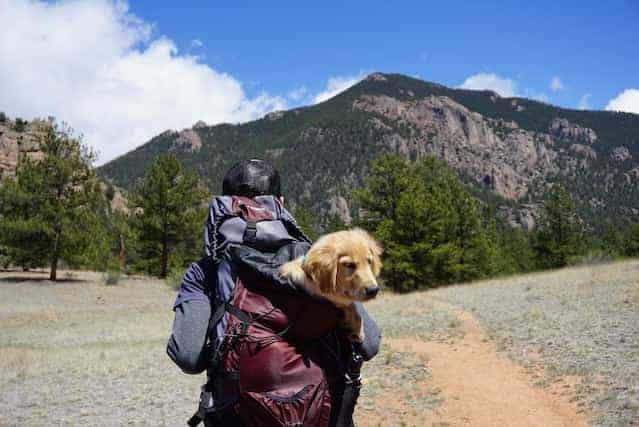
Bringing your furry friend along for a backpacking adventure can be a rewarding experience for both you and your pet. To ensure a safe and enjoyable trip, consider the following tips:
Choose Pet-Friendly Trails
Before hitting the trail with your pet, research pet-friendly trails and regulations. Some trails may have restrictions on pets, or certain areas may be off-limits to protect local wildlife. Ensure you’re aware of and adhere to any rules in place, and always keep your pet on a leash when required.
Prepare Your Pet for the Trail
Preparing your pet for a backpacking trip involves more than just packing their gear. Begin by assessing their fitness level, as backpacking can be physically demanding. Gradually increase the duration and intensity of your walks or hikes to build up their stamina. Make sure your pet is well-trained and can respond to basic commands, such as “come,” “stay,” and “leave it.” This will help you maintain control and ensure their safety on the trail.
Gear Up Your Pet
Just like you need the right gear for backpacking, so does your pet. Invest in a comfortable, well-fitting harness, and consider a backpack designed specifically for pets, so they can help carry their supplies. Ensure they have a proper collar with identification tags and a sturdy leash. Don’t forget to pack essentials like food, water, and a collapsible bowl for their meals, as well as any necessary medications or first-aid items.
Monitor Your Pet’s Health and Well-being
During your backpacking trip, keep a close eye on your pet’s health and well-being. Watch for signs of fatigue, overheating, or discomfort, and adjust your pace and distance accordingly. Check their paws regularly for cuts or abrasions and clean them as needed. Be mindful of the terrain and weather conditions, and provide extra warmth, shade, or rest when necessary.
Practice Leave No Trace Principles with Your Pet
As a responsible pet owner, it’s essential to follow Leave No Trace principles (shared later in this article) while backpacking with your pet. Always pick up and pack out their waste, or bury it according to guidelines if permitted. Keep your pet from disturbing wildlife, and avoid letting them wander off-trail to minimize their impact on the environment.
Tips for Backpacking with Family

Taking your family on a backpacking adventure can create unforgettable memories and strengthen bonds. To ensure a successful and enjoyable experience for everyone, consider the following tips:
Include the Whole Family in Planning
Incorporate all family members in the planning process to foster a sense of excitement and investment in the trip. Discuss potential destinations, activities, and objectives, considering each person’s interests and abilities. Involving everyone in the planning cultivates a shared sense of ownership and anticipation.
Select Age-Appropriate Trails and Activities
Choose trails and activities that accommodate your family’s ages and fitness levels. Younger children may require shorter distances and less challenging terrain, while older kids might be ready for more demanding hikes. Research family-friendly trails, campsites, and activities to ensure an engaging and enjoyable experience for all.
Pack Light and Share Gear
When backpacking with family, it’s crucial to minimize your overall gear load. Share communal items like tents, stoves, and cookware to save weight and space. Teach children the importance of packing light and only bringing essential items, and consider using a gear checklist to avoid overpacking.
Overcoming Common Challenges

Backpacking can present various challenges, but with preparation and the right mindset, you can overcome them. Here are some common challenges and tips for overcoming them:
Dealing with Fatigue
Long days on the trail can be tiring, especially for beginners or those with less experience. To combat fatigue:
- Pace yourself and take regular breaks to rest and refuel.
- Stay hydrated and maintain a balanced diet.
- Break up your day with shorter hikes and enjoyable activities, like swimming or photography.
Adapting to Changing Weather Conditions
Weather can be unpredictable, so it’s essential to be prepared for various conditions. Stay adaptable by:
- Checking the weather forecast before your trip and monitoring conditions throughout.
- Packing appropriate clothing layers and rain gear.
- Knowing when to alter your plans or seek shelter for safety.
Navigating Difficult Terrain
Some trails may have challenging sections or obstacles. To safely navigate these:
- Research the trail beforehand to familiarize yourself with any difficult sections.
- Use trekking poles for additional support and stability.
- Practice good communication and teamwork with your group, helping each other when needed.
Building a Backpacking Community
Having a support network of fellow backpackers can enhance your experiences and provide valuable resources. Here are some ways to build a backpacking community:
Join Local Hiking and Backpacking Groups
Search for local clubs, organizations, or Meetup groups focused on hiking and backpacking. These groups often organize group hikes, educational events, and social gatherings, providing opportunities to connect with like-minded individuals.
Attend Workshops and Events
Outdoor retailers and organizations often host workshops, presentations, and other events related to backpacking. Attending these events can help you learn new skills, gain knowledge, and meet fellow backpackers.
Engage in Online Backpacking Communities
Join online forums, social media groups, or follow blogs and websites dedicated to backpacking. These platforms allow you to ask questions, share experiences, and connect with others who share your passion for backpacking.
Budgeting and Permits for Your Backpacking Trip

Embarking on a backpacking trip requires some financial planning and awareness of necessary permits. Here’s what you need to know to stay within budget and ensure you have the required permissions for your adventure.
Create a Backpacking Budget
Budgeting for your backpacking trip involves considering various costs, such as transportation, gear, food, and permits. Begin by listing all the necessary expenses and categorizing them as one-time costs (like purchasing gear) or ongoing costs (like food and fuel). Research prices for your specific needs and prioritize your spending, focusing on essential items first. Remember to set aside some money for unexpected expenses or emergencies.
Save Money on Gear
Quality gear can be expensive, but there are ways to save money without compromising on safety and comfort. Look for deals and discounts at outdoor retailers, or consider buying gently used equipment from second-hand stores or online marketplaces. You might also consider borrowing or renting gear from friends or outdoor organizations. Keep in mind that investing in quality, durable items can save you money in the long run.
Permits and Regulations
You may need permits for backpacking, camping, or entering specific areas depending on your chosen destination. Research the permit requirements for your trip, and apply for them well in advance, as some may have limited availability or seasonal restrictions. Familiarize yourself with the rules and regulations of the area you’ll be visiting, including campsite locations, fire restrictions, and trail etiquette.
Leave No Trace Principles
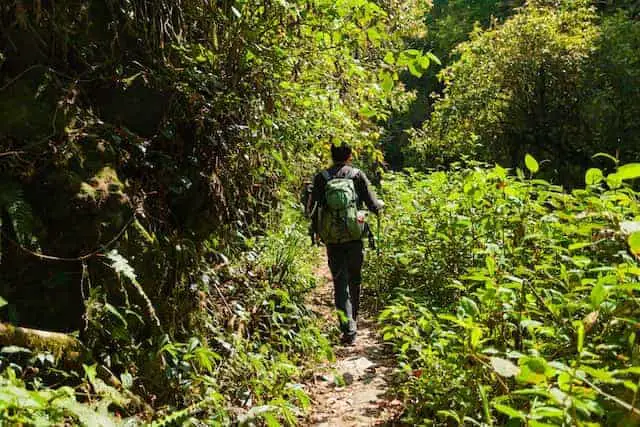
As backpackers, we have a responsibility to protect and preserve the natural environments we explore. By adhering to Leave No Trace principles, you minimize your impact on the wilderness and promote responsible outdoor ethics. Here are the seven principles to follow:
Plan Ahead and Prepare
- Research your destination, including rules, regulations, and potential hazards.
- Prepare for changes in weather, emergencies, and plan your route accordingly.
Travel and Camp on Durable Surfaces
- Stick to established trails and campsites to minimize damage to vegetation and soil.
- Set up camp at least 200 feet away from lakes and streams to protect water sources.
Dispose of Waste Properly
- Pack out all trash, leftover food, and litter.
- Use biodegradable soap and dispose of wastewater away from water sources.
- Dig a “cathole” at least 6-8 inches deep and 200 feet from water sources to bury human waste.
Leave What You Find
- Avoid picking plants, moving rocks, or disturbing wildlife and historical artifacts.
- Leave natural and cultural features undisturbed for others to enjoy.
Minimize Campfire Impact
- Use a camp stove for cooking instead of making a fire, if possible.
- Keep fires small and use established fire rings or fire pans.
- Burn only small sticks and twigs, and put out fires completely before leaving.
Respect Wildlife
- Observe animals from a distance and avoid feeding them or approaching too closely.
- Store food and trash securely to prevent wildlife from accessing it.
Be Considerate of Other Visitors
- Keep noise levels down and respect the tranquility of nature.
- Yield to other hikers on the trail and follow proper trail etiquette.
By following these principles, you preserve the natural beauty of the outdoors and ensure a positive experience for future backpackers.
Final Thoughts and Encouragement
As you prepare to embark on your first backpacking adventure, remember that the journey is just as important as the destination. Embrace the challenges and joys that come with exploring the great outdoors, and know that you have a community of fellow backpackers cheering you on. This guide has equipped you with the knowledge and tools needed to confidently navigate your way through the wild. So, trust in yourself, stay open to learning, and enjoy the sense of accomplishment that comes from tackling your first backpacking trip. The trail is calling, and countless adventures await – happy backpacking!

Michael is heavily inclined towards traveling to natural places and documenting cultures/people from different parts of the world. He also loves hiking and camping and is spirited toward all outdoor activities. He will share his passion for outdoor life and brands or products we use outside our homes. He has good research skills, and that’s why you can see why his articles are packed with info that is factual and not readily available. He also has the vision to travel the whole world and share it with all readers of Outdoor Favor.

